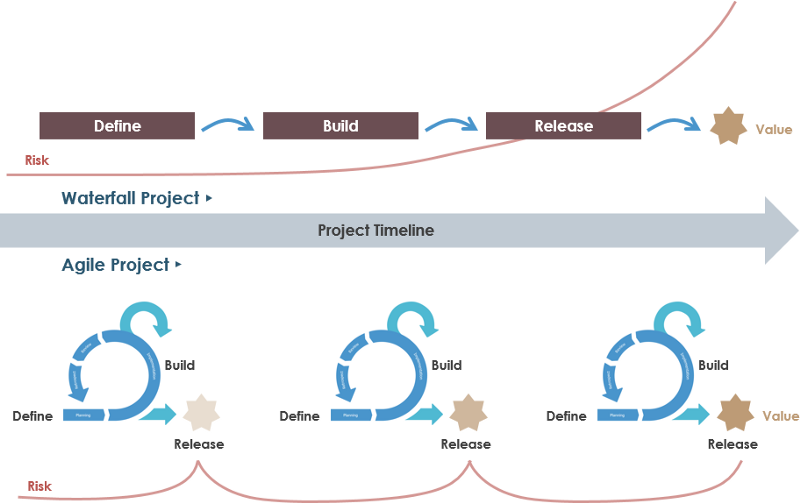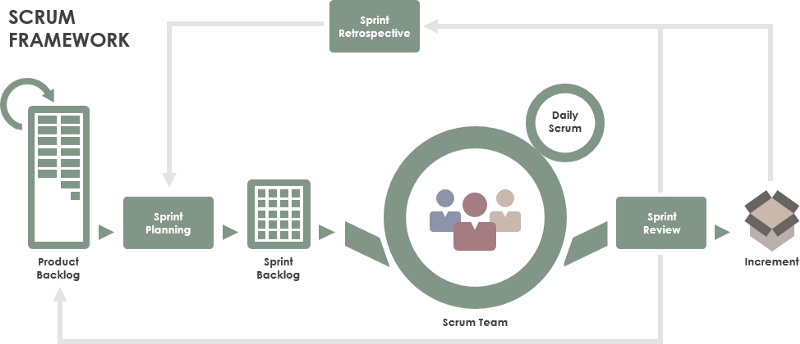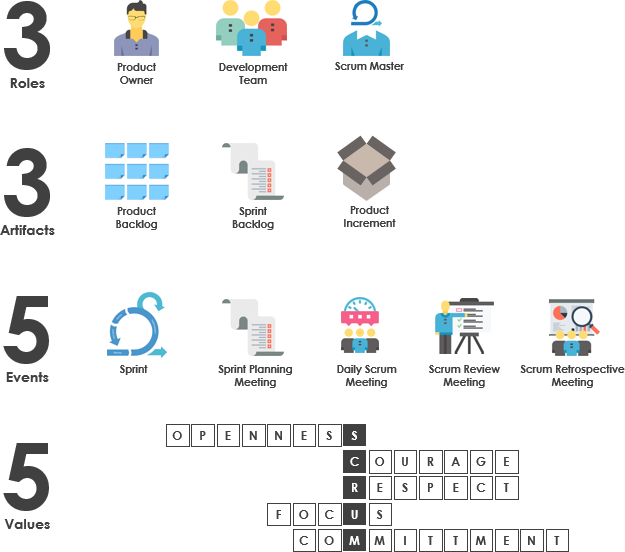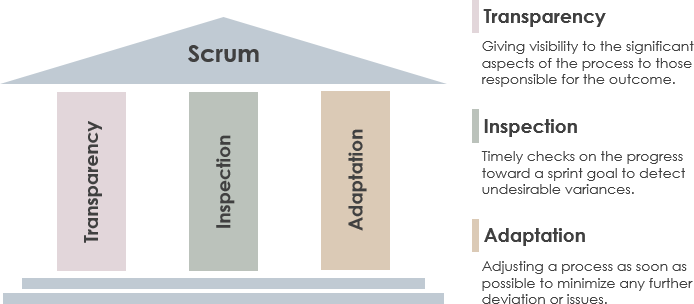Scrum là một khuôn khổ cho việc phát triển, giao hàng và cải tiến liên tục các sản phẩm phức tạp. Đây là một quy trình phát triển theo từng giai đoạn và lặp lại.

- Trong khuôn khổ này, toàn bộ quy trình phát triển bao gồm nhiều chu kỳ lặp ngắn. Một chu kỳ lặp ngắn được gọi là Sprint, và độ dài khuyến nghị của mỗi Sprint là từ một đến bốn tuần.
- Trong Scrum, danh sách yêu cầu sản phẩm được sử dụng để quản lý các yêu cầu sản phẩm. Danh sách yêu cầu sản phẩm là một danh sách các yêu cầu được sắp xếp theo giá trị kinh doanh, và hình thức của các mục trong danh sách thường là một câu chuyện người dùng.
- Đội ngũ Scrumluôn phát triển trước các yêu cầu có giá trị cao hơn cho khách hàng. Trong Sprint, đội ngũ Scrum chọn các yêu cầu có ưu tiên cao nhất từ danh sách yêu cầu sản phẩm để phát triển.
- Các yêu cầu đã chọn được thảo luận, phân tích và ước lượng tại cuộc họp lập kế hoạch Sprint để có được danh sách nhiệm vụ tương ứng, mà chúng tôi gọi là danh sách nhiệm vụ Sprint.
- Vào cuối mỗi chu kỳ lặp, đội ngũ Scrum sẽ giao hàng các phần sản phẩm có thể giao.

Scrum bắt nguồn từ các dự án phát triển phần mềm, nhưng nó phù hợp cho bất kỳ dự án phức tạp hoặc đổi mới nào. Scrum đã được sử dụng để phát triển phần mềm, phần cứng, phần mềm nhúng, mạng chức năng tương tác, lái xe tự động, trường học, chính phủ, thị trường, tổ chức quản lý và hoạt động, và gần như mọi thứ mà chúng tôi (như cá nhân và nhóm) sử dụng trong cuộc sống hàng ngày.
Khuôn khổ SCRUM (3355)
Khuôn khổ Scrum bao gồm 3 vai trò, 3 sản phẩm, 5 sự kiện và 5 giá trị:
3 nhân vật
3 sản phẩm
- Danh sách yêu cầu sản phẩm (Danh sách yêu cầu sản phẩm)
- Danh sách nhiệm vụ Sprint
- Phần sản phẩm (Phần tăng thêm)
5 sự kiện
- Sprint (Sprint tự nó là một sự kiện, bao gồm 4 sự kiện sau)
- Cuộc họp lập kế hoạch Sprint (Cuộc họp lập kế hoạch Sprint)
- Cuộc họp Scrum hàng ngày
- Cuộc họp đánh giá Sprint (Cuộc họp đánh giá Sprint)
- Cuộc họp hồi tưởng Sprint
5 giá trị
- Cam kết — sẵn sàng cam kết với mục tiêu
- Tập trung — sử dụng tâm trí và khả năng của bạn cho công việc mà bạn đã hứa
- Cởi mở — Scrum làm cho mọi thứ trong dự án trở nên công khai với mọi người
- Tôn trọng — mỗi người đều có nền tảng và kinh nghiệm độc đáo của riêng mình
- Dũng cảm — hãy có can đảm để đưa ra lời hứa, thực hiện lời hứa và chấp nhận sự tôn trọng của người khác

Khung SCRUM — Ba trụ cột
Scrum là một quy trình dựa trên lý thuyết kiểm soát quy trình thực nghiệm (thực nghiệm). Thực nghiệm khẳng định rằng kiến thức được rút ra từ kinh nghiệm và rằng các quyết định được đưa ra dựa trên những gì đã biết. Scrum sử dụng một phương pháp lặp đi lặp lại và gia tăng để tối ưu hóa khả năng dự đoán và kiểm soát rủi ro.
Cuộc ba trụ cột của Scrum hỗ trợ việc thực hiện mỗi quy trình kiểm soát thực nghiệm: tính minh bạch, kiểm tra và điều chỉnh. Ba trụ cột của Scrum như sau:
1. Tính minh bạch
Tính minh bạch đề cập đến việc duy trì một mức độ cao về khả năng nhìn thấy trong tất cả các khía cạnh của quy trình phát triển phần mềm, và tất cả các khía cạnh ảnh hưởng đến kết quả giao hàng đều phải minh bạch với tất cả những người tham gia vào việc giao hàng và những người quản lý kết quả sản xuất. Những người quản lý kết quả sản xuất không chỉ cần có khả năng nhìn thấy những khía cạnh này của quy trình, mà họ cũng phải hiểu những gì họ thấy. Nói cách khác, khi ai đó đang kiểm tra một quy trình và chắc chắn rằng một nhiệm vụ nhất định đã hoàn thành, thì sự hoàn thành đó phải tương đương với định nghĩa về sự hoàn thành của họ.
2. Kiểm tra
Tất cả các khía cạnh của quy trình phát triển phải được kiểm tra đủ thường xuyên để đảm bảo rằng các sai lệch lớn trong quy trình có thể được phát hiện kịp thời. Khi xác định tần suất kiểm tra, cần xem xét rằng việc kiểm tra sẽ gây ra sự thay đổi trong tất cả các quy trình. Khi tần suất kiểm tra được chỉ định vượt quá mức độ dung sai của việc kiểm tra quy trình, thì sẽ phát sinh vấn đề. May mắn thay, điều này không xảy ra trong phát triển phần mềm. Một yếu tố khác là trình độ kỹ năng và sự nhiệt tình của nhân viên kiểm tra kết quả công việc.
3. Điều chỉnh
Nếu người kiểm tra phát hiện rằng một hoặc nhiều khía cạnh của quy trình không đáp ứng các tiêu chí chấp nhận trong quá trình kiểm tra, và sản phẩm cuối cùng không đạt yêu cầu, thì quy trình hoặc tài liệu cần phải được điều chỉnh. Các điều chỉnh phải được thực hiện càng sớm càng tốt để giảm thiểu các sai lệch tiếp theo.

Trong Scrum, việc kiểm tra và điều chỉnh được thực hiện thông qua ba hoạt động:
- Cuộc họp hàng ngày để kiểm tra tiến độ của các mục tiêu Sprint và thực hiện điều chỉnh để tối ưu hóa giá trị công việc của ngày hôm sau;
- Đánh giá Sprint và các cuộc họp lập kế hoạch kiểm tra tiến độ của mục tiêu phát hành và thực hiện điều chỉnh để tối ưu hóa giá trị công việc của Sprint tiếp theo;
- Cuộc họp tổng kết Sprint được sử dụng để xem xét Sprint đã hoàn thành và xác định những cải tiến nào có thể được thực hiện để làm cho Sprint tiếp theo hiệu quả hơn, thỏa mãn hơn và vui vẻ hơn trong công việc.
Tài liệu tham khảo: Cơ bản về Scrum
- Hướng dẫn toàn diện về Scrum
- Quản lý sản phẩm Agile với Scrum trong một cái nhìn tổng quan
- Ba trụ cột của Scrum là gì?
- Phát triển phần mềm Agile là gì?
- Quản lý dự án Agile là gì?
- Scrum trong 3 phút
- Năm giá trị của Scrum là gì?
- Sự tiến hóa của Scrum là gì?
This post is also available in Deutsch, English, Español, فارسی, Français, Bahasa Indonesia, 日本語, Polski, Portuguese, Ру́сский, 简体中文 and 繁體中文.













